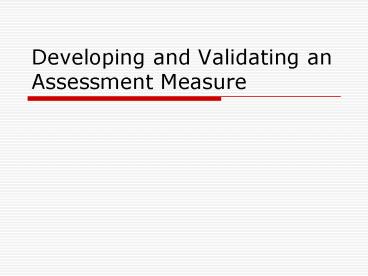Developing and Validating an Assessment Measure - PowerPoint PPT Presentation
Title:
Developing and Validating an Assessment Measure
Description:
Developing and Validating an Assessment Measure Goals, Objectives & Criteria It is critical that employees have a clear understanding about what part of their ... – PowerPoint PPT presentation
Number of Views:59
Avg rating:3.0/5.0
Title: Developing and Validating an Assessment Measure
1
Developing and Validating an Assessment Measure
2
Goals, Objectives Criteria
- It is critical that employees have a clear
understanding about what part of their
performance is appraised and how it will be
measured. - Performance can be measured according to
previously established and mutually understood
goals between the employee and the supervisor. - Goals should be challenging but attainable.
- Goals must be related to the core
responsibilities. - After the goals and objectives are established,
criteria against which the employee's job
performance can be evaluated are agreed upon.
Criteria are the indicators of successful
performance on the job.
3
Good performance goals, objectives, and criteria
are
- job related
- challenging, but achievable
- clearly communicated mutually understood
- specific and objective
- time-oriented
- written
- subject to revision, as needed
4
Six Steps
- (1) conducting a job analysis
- (2) developing predictors
- (3) developing criterion measures
- (4) administer predictor criterion measures
- (5) conducting validation fairness analyses
- (6) implementation
5
Examples
- Lets review a few cases
- http//www.pdri.com/value/assess
6
The errors we make
7
Halo/Horn Error
- Halo error - Occurs when supervisor generalizes
one positive performance feature or incident to
all aspects of employee performance resulting in
higher rating - Horn error - Evaluation error occurs when
supervisor generalizes one negative performance
feature or incident to all aspects of employee
performance resulting in lower rating
8
Leniency/Strictness
- Leniency - Giving undeserved high ratings
- Strictness - Being unduly critical of employees
work performance - Worst situation is when institution has both
lenient and strict supervisors and does nothing
to level inequities
9
Central Tendency
- Error occurs when employees are incorrectly rated
near average or middle of scale - May be encouraged by some rating scale systems
requiring evaluator to justify in writing
extremely high or extremely low ratings
10
Recent Behavior Bias
- Employees behavior often improves and
productivity tends to rise several days or weeks
before scheduled evaluation - Only natural for rater to remember recent
behavior more clearly than actions from more
distant past - Maintaining records of performance
11
Personal Bias (Stereotyping)
- Supervisors allow individual differences such as
gender, race or age to affect ratings they give - Effects of cultural bias, or stereotyping, can
influence appraisals - Other factors
- like an individual that may be appraised more
harshly simply because they do not seriously
object to results
12
Manipulating the Evaluation
- Sometimes, supervisors control virtually every
aspect of appraisal process and are in position
to manipulate system - Example Want to give pay raise to certain
employee. Supervisor may give employee an
undeserved high performance evaluation
13
Employee Anxiety
- Evaluation process may create anxiety for
appraised employee - Opportunities for promotion, better work
assignments, and increased compensation may hinge
on results
14
Establishing Performance Criteria (Standards)
- Traits
- Behaviors
- Competencies
- Goal Achievement
- Improvement Potential
15
THREE FOCAL POINTS OF APPRAISAL
- 1. PERSONAL TRAITS AND CHARACTERISTICS
- inexpensive to develop and use
- not specialized by position one form for all
workers - - high potential for bias and rating errors
- - not very useful for feedback or development
- - not easily justifiable for reward/promotion
decisions - 2. JOB BEHAVIOR AND ACTIVITY
- can focus on specific duties listed in the
job description - intuitively acceptable to employees and
superiors - useful for providing feedback
- seem fair for reward and promotion decisions
- - are time consuming to develop and use
- - can be costly to develop
- - have some potential for rating error and bias
16
THREE FOCAL POINTS OF APPRAISAL
- 3. WORK RESULTS AND OUTCOMES
- less subjectivity bias
- acceptable to employees and superiors
- links individual performance to
organizational objectives - seem fair for reward and promotion decisions
- - are time consuming to develop and use
- - may encourage a short-term perspective
- - may use deficient or inappropriate criteria
17
GOALSETTING ISSUES
- GOAL DIFFICULTY How challenging should the work
objectives be? I want an easy goal, but the
organization wants me to stretch. - ACCEPTANCE Will workers feel committed to work
toward objectives that have been assigned to
them, rather than those set participatively? - SPECIFICITY Precise quantitative indicators may
not exist for critical elements of the job.
General, open-ended goals are not easily
assessed. - MOTIVATION Objectives should be challenging,
yet reachable. They also need to be linked to
desirable rewards to successfully motivate
workers.































